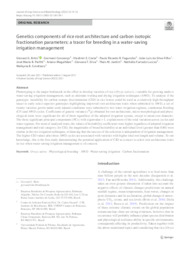Genetics components of rice root architecture and carbon isotopic fractionation parameters: a tracer for breeding in a water saving irrigation management.
Genetics components of rice root architecture and carbon isotopic fractionation parameters: a tracer for breeding in a water saving irrigation management.
Autoria: BRITO, G. G. de; CONCENÇO, G.; COSTA, V. E.; FAGUNDES, P. R. R.; SILVA FILHO, J. L. da; PARFITT, J. M. B.; MAGALHAES JUNIOR, A. M. de; SILVA, G. T.; JARDIM, T. M.; LUCCAS, N. F.; SCIVITTARO, W. B.
Resumo: Phenotyping is the major bottleneck in the effort to develop varieties of rice (Oryza sativa L) suitable for grow under a water saving irrigation management, such as alternate wetting and drying irrigation technique (AWD). In order to analyze if the genotypic variability for carbon isotope discrimination (CID) in rice leaves could be used as a relatively high-throughput tracer to early select superior genotypes highlighting improved root architecture traits when submitted to AWD, a set of twenty varieties grown under semi-natural conditions were submitted to two water irrigation regimes, continuous ooding (CF) and AWD cycles. Coecients of genetic variance (π2g) obtained for root architecture, micro-morphological and physiological traits were signicant for all of them regardless of adopted irrigation system, except to mean root diameter. The three signicant principal components (PCs) with eigenvalue > 1, explain the most of the total variation across cycles and water regimes. For most of analyzed traits, the values of heritability coecients were higher regardless of adopted irrigation management and trait category; for CID, the magnitudes of broad heritability at individual level (greater than 0.80) were similar in the two irrigation techniques, evidencing that the success of selection is independent of irrigation management. The higher CID values after three AWD cycles are associated to varieties with higher total root length and volume. To our knowledge, this is the rst study demonstrating the potential application of CID as tracer to select root architecture traits in rice when water-saving irrigation management are of concern.
Ano de publicação: 2022
Tipo de publicação: Artigo de periódico
Unidade: Embrapa Clima Temperado
Palavras-chave: Arroz, Carbono, Discriminação de isótopos de carbono, Irrigação
Observações
1 - Por padrão são exibidas publicações dos últimos 20 anos. Para encontrar publicações mais antigas, configure o filtro ano de publicação, colocando o ano a partir do qual você deseja encontrar publicações. O filtro está na coluna da esquerda na busca acima.
2 - Para ler algumas publicações da Embrapa (apenas as que estão em formato ePub), é necessário ter, no celular ou computador, um desses softwares gratuitos. Sistemas Android: Google Play Livros; IOS: iBooks; Windows e Linux: software Calibre.
Acesse outras publicações
Acesse a Base de Dados da Pesquisa Agropecuária (BDPA) para consultar o acervo completo das bibliotecas da Embrapa.

